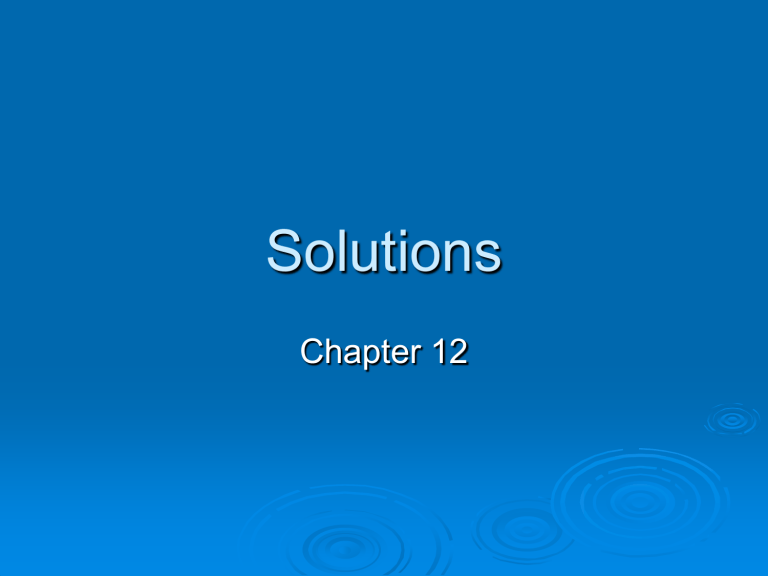Solutions

Solutions
Chapter 12
Solubility and the Solution Process
Unsaturated, Saturated, and Supersaturated
Solutions
unsaturated: amount of solute that a solvent can hold at specific temperature contains less than the maximum
saturated: contains the maximum amount of solute that a solvent can hold at specific temperature
supersaturated: contains more than the maximum amount of solute that a solvent can hold at specific temperature
How?
At higher temperature, solvents can hold more solute than at lower temperature. If a given amount of solute is dissolved in a solvent at a higher temperature, then allowed to cool without being disturbed, the solute will remain in solution.
The solution is unstable, though, and the solute will fall out of solution if the solution is disturbed.
This is the principle behind hot and cold packs. Hot packs are made from substances that recrystallize in an exothermic reaction; cold packs are made from substances that recrystallize in an endothermic reaction.
Factors in Explaining Solubility
Three types of interactions to consider for solutions:
1. solvent-solvent interaction
2. solute-solute interaction
3. solvent-solute interaction
Consider the solution process taking place in three distinct steps:
1. separation of solvent molecules
2. separation of solute molecules
3. mixing of solvent and solute molecules
So why don't all liquids mix and all solids dissolve in liquids?
If solvent-solute interaction can't compete with solute-solute and solvent-solvent interactions, they remain separated.
When solute-solute or solvent-solvent interactions are stronger than solutesolvent interactions, solute and solvent stay separated.
When solute-solvent interactions are as strong as solute-solute and solvent-solvent interactions , solute and solvent mix.
Liquid-Liquid Solutions
"Like dissolves like" rule
polar molecules will mix (be miscible with) other polar molecules
nonpolar molecules will mix (be miscible with) other nonpolar molecules
polar molecules will not mix (be immiscible with) nonpolar molecules
Solid-Liquid Solutions
Ionic and Molecular Compounds
“Like dissolves like” rule applies!
solid solute
Polar
Nonpolar
Ionic polar solvent soluble insoluble
Check Solubility Rules nonpolar solvents insoluble soluble insoluble
Note: You need to be able to determine whether a compound is polar or nonpolar given only its formula
–i.e. get the Lewis structure, and use VSEPR to determine shape, then polarity.
Some solids will not dissolve in any solvent
– network covalent solids (eg. graphite, quartz) never dissolve in any solvent
– metals do not "dissolve" –they may react with but do not dissolve–in solvents
Effects of Temperature and
Pressure on Solublility
Gas solubility and Temperature:
As T ↑, solubility of a gas in a liquid ↓ (in most cases)
• a glass of soda quickly goes flat if left out on a hot summer day
• why bubbles form when water heated in open pan (dissolved air escaping)
Why?
At higher T, gas molecules are moving more quickly
they have a higher tendency to find the surface (b/w liquid and air) they escape more quickly fewer gas molecules in the liquid!
Effects of Temperature and
Pressure on Solublility cont.
Gas solubility and Pressure:
Henry’s Law: Solubility of gas is proportional to partial P of gas above liquid
Why?
Greater gas pressure = more gas molecules over solution
more gas molecules encounter liquid surface
more gas molecules go into the liquid phase!
Practical applications:
• Why sodas can't be as carbonated after being opened
• Why divers get the "bends" – air dissolved in blood and other bodily fluids bubbles out when divers go from deep water (high pressure) to the surface (low pressure)
Effects of Temperature and
Pressure on Solublility cont.
Solid solubility and Temperature:
As T ↑, solubility of a solid in a liquid ↑ (in most cases)
• e.g. we can dissolve more sugar in a cup of hot tea than in glass of iced tea
Ways of Expressing Concentration
Ways of Expressing Concentration
Cont.
Comparison of Concentration
Units
mole fractions: used for partial pressures of gases and for dealing with vapor pressures of solutions molarity: preferred over molality because easier to measure volume of a solution using calibrated glassware than to weigh solvent molality: independent of temperature, whereas molarity varies with temperature since volume varies
useful when experiment carried out over a range of temperatures mass percent: independent of temperature; molar masses not needed parts per million: for very low concentrations of solute (impurities, pollutants)
Be able to use unit analysis to convert from one concentration unit to another!






